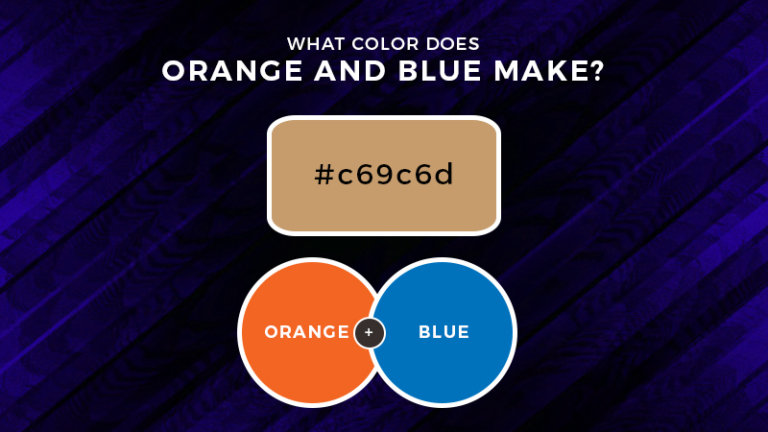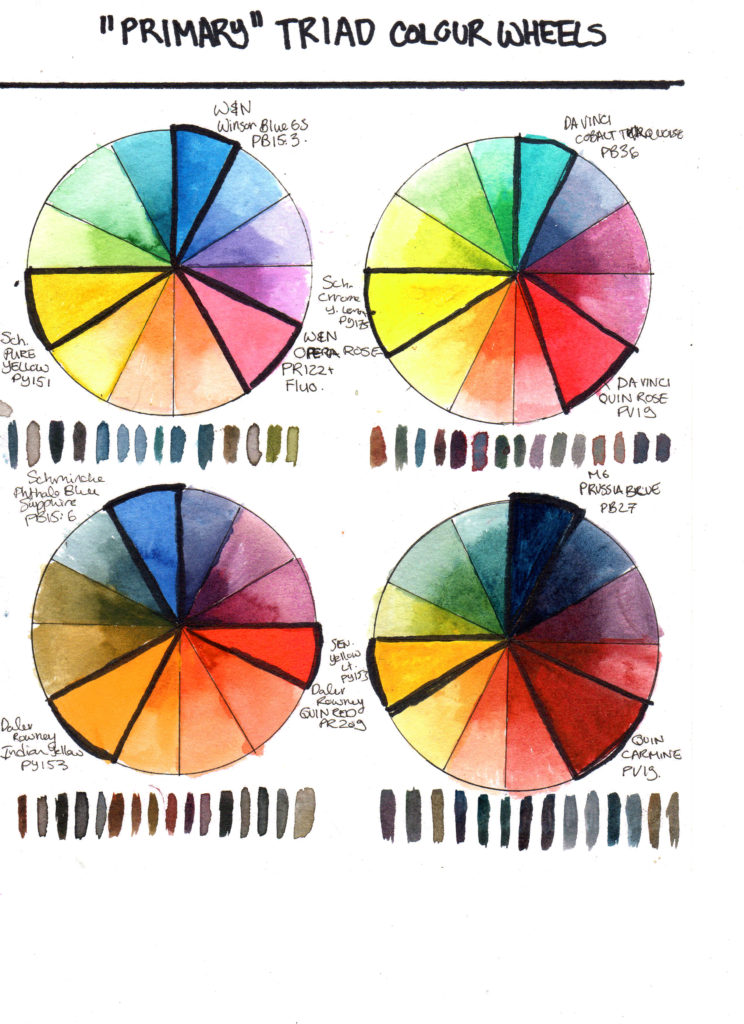The mixing of colored physical substances corresponds to subtractive color mixing, hence it corresponds to our intuition about mixing colors. To explain the mechanism, consider mixing red paint with yellow paint. The red paint is red because when the ambient light strikes it, the composition of the material is such that it absorbs all other colors in the visible spectrum except for red. The red light, not being absorbed, reflects off the paint, and is what we see. This same mechanism describes the color of material objects – note that light is not a material object – and so applies to the yellow paint as well.
Making recourse to the figure above demonstrating additive color mixing, one sees that yellow light is composed of an mixture of red and green light. When we mix the two paints, the resulting substance has red paint and yellow paint. The yellow paint absorbs all colors except for red and green. However, the red paint will absorb the green reflected by the yellow paint. The red paint can be said to subtract the green from the yellow paint.
The resulting paint reflects only red light and so appears red to our eyes. This results in a darker and desaturated color compared to the color that would be achieved with ideal filters. A cyan surface absorbs red, just as a magenta surface absorbs green, and a yellow surface absorbs blue. If you shine red light on a yellow surface, it will appear black. You can make a surface appear any color in the visible spectrum by absorbing different amounts of red, green and blue with cyan, magenta, and yellow pigments.
In the applet on the next page, you can play around with various mixtures of the three subtractive primary colors to make any color you want. Note that an equal mixture of the three primary subtractive colors absorbs red, green, and blue, and therefore appears black. However, this is not an effective way to print in black because you use a lot of ink and the final result often is grayish has a color cast. That is why you also purchased a black cartridge separately. Note that modern printers do a very good job a recreating all the colors in a photograph with the three subtractive primaries and black. More demanding printing technologies use more pigments to be able to reproduce the original colors with even greater accuracy.
Cyan, magenta and yellow are the primary colors of pigments, combining to make black. Red, blue and green are the primary colors of light, combining to make white. Yellow pigment absorbs blue light and cyan absorbs red light.
When white light passes through yellow and cyan ink layers on paper and reflects back off the paper, all but the green light is absorbed so we see green being reflected. In order for green light to be absorbed and not reflected it would have to pass through magenta pigment. The three primary colors typically used in subtractive color mixing systems are cyan, magenta, and yellow, corresponding to the CMY color model and CMYK color model widely used in color printing.
In subtractive mixing of color, the absence of color is white and the presence of all three primary colors makes a neutral dark gray or black. The secondary colors are the same as the primary colors from additive mixing and vice versa. Subtractive mixing is used to create a variety of colors when printing or painting on paper or other white substrates, by combining a small number of ink or paint colors.
Black can be approximated by mixing cyan, magenta, and yellow, although real pigments are not ideal and so pure black is nearly impossible to achieve. Paints, inks, photographs, and dyes get their colors from pigments. A pigment is a material that absorbs some colors of light and reflects other colors. Stone Age cave paintings were made with natural pigments from colored earth and clay.
Over the centuries, natural pigments have been obtained from many sources, including metal oxide compounds, minerals, plants, and animals. Today's artists use paints made from natural pigments as well as from synthetic, or manufactured pigments. The primary colors of pigments are cyan, yellow, and magenta.
You can mix varying amound of these primary pigment colors to make almost any other color. As pigments are mixed together, more colors are absorbed and fewer colors are reflected. When two or more pigments are mixed together, the colors absorbed by each pigment are subtracted out of the light that strikes the mixture. When cyan and magenta are combined, blue is formed.
The secondary colors of pigments are red, green, and blue. Any two colors of pigments that combine to make black pigment are complementary colors of pigments. Pigments are chemicals that absorb selective wavelengths—they prevent certain wavelengths of light from being transmitted or reflected. Because paints contain pigments, when white light shines on colored paint, only some of the wavelengths of light are reflected.
For example, cyan paint absorbs red light but reflects blue and green light; yellow paint absorbs blue light but reflects red and green light. If cyan paint is mixed with yellow paint, you see green paint because both red and blue light are absorbed and only green light is reflected. In the subtractive color mixing demonstration, the same blue and yellow filters are both placed over a single beam of light. Three transparent protractors are overlaid on top of each other. The protractors are colored cyan, magenta, and yellow.
The three protractors are illuminated with white light, sometimes referred to as RGB light. Each protractor absorbs a single primary color of light. Where two protractors overlap, a single primary color of light shows through. For example, where the cyan and the yellow protractor overlap, the red and blue light are absorbed and the green light is seem shining through.
And where the cyan and the magenta protractor overlap, the red and green light are absorbed and the blue light is seem shining through. Finally, where the magenta and the yellow protractor overlap, the green and blue light are absorbed and the red light is seem shining through. This photo illustrates the principles of color subtraction. The color wheel taught to most people today is the twelve hue color circle developed by Johannes Itten. This color wheel is based on a triadic mixture of pigments with red, yellow, and blue as the primary triad. All hues are formed from mixtures of equal or unequal amounts of primaries.
Equal mixtures of two primaries result in the secondary hues and form the triad of green, orange, and violet. In this color wheel, six intermediate hues are created by equal mixtures of primary and secondary colors and form two more triads. When mixing pigments, color mixture is described as subtractive.
When white light hits a surface most of the light energy is absorbed. We perceive only the color that is reflected from the surface. In this situation, the part of the spectrum that is absorbed is "subtracted" from white light.
To begin, consider white light to consist of the three primary colors of light - red, green and blue. If white light is shining on a shirt, then red, green and blue light is shining on the shirt. If the shirt absorbs blue light, then only red and green light will be reflected from the shirt. So while red, green and blue light shine upon the shirt, only red and green light will reflect from it. Red and green light striking your eye always gives the appearance of yellow; for this reason, the shirt will appear yellow.
This discussion illustrates the process of color subtraction. The process is depicted visually by diagram at the right. Furthermore, the process is depicted in terms of an equation in the space below.
Imagine a theatrical lighting instrument pointed at our white screen. It produces a full spectrum of light, and the screen appears white. We then add a blue "gel" to the light and our screen appears blue. This is the most common example of subtractive color mixing in theatre. Gels, so called because they were originally made of gelatin , are colored filters placed in front of a white light to alter its color. As the name "filter" implies, the material only allows certain wavelengths of light through and blocks the rest, converting them mainly into heat.
By removing or subtracting part of the color spectrum, our eyes perceive a different color from white. Subtractive color mixing is also how most non-LED moving lights produce their color range. Using filters of the secondary colors in various combinations, they produce the full array of colors through subtractive color mixing. In the example below, a cyan filter prevents red light from passing through , and magenta prevents green light from passing through. By combining the cyan and magenta filters, you produce only blue light, as all red and green light is stopped by the filters.
Interestingly, if you combine all three secondary colors using subtractive color mixing, you will have blocked nearly all of the light ― essentially mixing the three secondaries to produce black. So the distinction in color systems really comes down to the chemical makeup of the objects involved and how they reflect light. Additive theory is based on objects that emit light, while subtractive deals with material objects like books and paintings. "Subtractive colors are those which reflect less light when they are mixed together," says Raiselis. By convention, the three primary colors in additive mixing are red, green, and blue. In the absence of light of any color, the result is black.
If all three primary colors of light are mixed in equal proportions, the result is neutral . When the red and green lights mix, the result is yellow. When green and blue lights mix, the result is a blue.
When the blue and red lights mix, the result is magenta. In additive color mixing, two sources of different colors are projected onto our white projection screen. Both colors are fully reflected to the viewer, and the brain perceives the two colors and creates the mixture. This process is called additive color mixing because we are adding two colors on top of each other to create a new color. For instance, we could shine separate red lights and blue lights onto our screen, and our brain would interpret this as magenta.
If we vary the intensity of the blue and red lights, the brain starts to move along the color wheel toward red or blue. More red light than blue light would give us a pinker color; more blue light than red light would give us a more purple color. The three primary colors of light for additive color mixing are red, green, and blue. When any two primary-color lights shine on a white object, the object appears to be the complementary color of the third primary color. For example, red and green light add to yellow, which is the complementary color of blue.
"When the blue flashlight circle intersects the green one, there is a lighter blue-green shape," he says. The first thing you have to understand that red, blue and yellow are not complementary colors. In additive color mixing red, blue and green are the scientific primaries, and as weird as it sounds, yellow is a secondary color of mixing red and green lights. "Subtractive colour mixing results when we mix together paints or inks," Westland says. "It relates to all of the colours we see of non-emissive objects, such as textiles, paints, plastics, inks, etc. "These materials are seen because they reflect the incident light that falls upon them. Take a piece of white paper; this paper reflects all of the wavelengths in the visible spectrum to a very high degree.
What happens when you mix cyan and yellow pigment The yellow ink absorbs the blue wavelengths, leaving the others — which are seen as yellow — to be reflected. So rather than being additive, in this case we start with white and then start to subtract light at certain wavelengths as we add the primaries." This makes subtractive color mixing the "black" color theory.
Mixing all three subtractive primaries produces a dark neutral, the opposite of white, because each paint subtracts or absorbs light that might be reflected by the other. Subtractive color mixtures can only be made lighter by diluting the amount of pigment in the mixture with white paint or water; either remedy weakens the color saturation. So subtractive mixture typically also reduces the hue purity in the color of mixed substances. An external source of illumination is assumed, and each primary attenuates some of that light. Combining all three primaries absorbs all the light, resulting in black. For real pigments, the results would be somewhat complicated by opacity and mixing behavior, and in practice adding a fourth pigment such as black may be helpful.
Yellow light shines on a sheet of paper containing a blue pigment. Determine the appearance of the paper.Yellow light can be thought of as consisting of red light and green light. A blue pigment is capable of absorbing yellow light. That is, blue paper can absorb both red and green primary colors of light . So red and green light shine on the paper; and both the red and the green light are subtracted.
There is no color left to be reflected to the eye. Yellow light shines on a sheet of paper containing a red pigment. A red pigment is capable of absorbing cyan light. That is, red paper can absorb both green and blue primary colors of light .
So red and green light shine on the paper; and green light is subtracted. (There is no need to subtract blue light since blue light is not shining on the paper.) This leaves red light to be reflected. If the paper reflects the red light, then the paper will look red. The primary colors of light are red, blue, andgreen.




























No comments:
Post a Comment
Note: Only a member of this blog may post a comment.